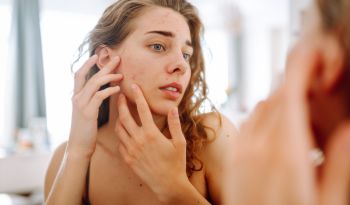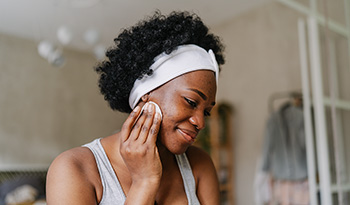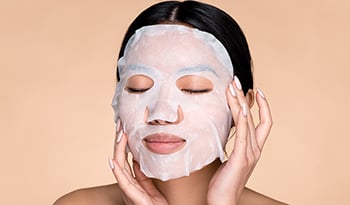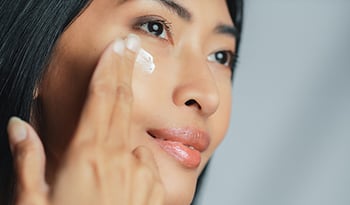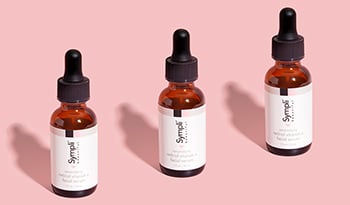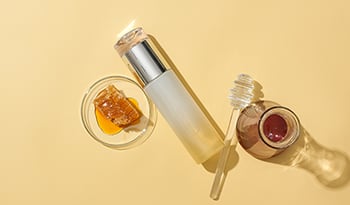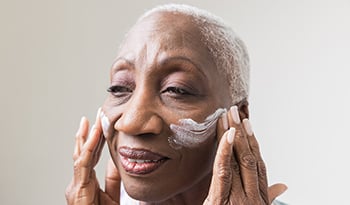5 Natural Ways To Fade the Appearance of Scars

Maybe you picked at a pimple, had a surgical procedure, or scraped your knee. Now you’re left with a scar–an unsightly reminder of that injury to your skin–and you just wish it would quickly fade away.
So, let’s look at how a scar develops. Then it will be easier to understand how we might minimize the appearance of a scar.
How Does a Scar Form?
When your skin is damaged, your body goes through four main phases of wound healing:
- Hemostasis is the formation of a blood clot to stop the flow of blood.
- Inflammation occurs as the body produces chemical signals at the site and blood vessels in the area dilate. This brings in nutrients and inflammatory cells to repair the wound.
- Proliferation is marked by fibroblasts coming to the wound site and secreting collagen, the proteins which provide structure to the developing scar tissue (initially called granulation tissue). The accumulation of collagen typically peaks about three weeks into wound healing. New blood vessels also form during the proliferation phase in order to replace the damaged vessels. This process is called angiogenesis.
- Remodeling (or maturation) is the final phase. Granulation tissue matures into scars during this time. Changes in the wound area occur which allow the collagen fibers to lie more closely together, ultimately decreasing the thickness of the scar. The strength of the scar reaches its maximum level at the end of this organization of collagen, which takes about six months. When there is too little collagen, the remodeling process may result in a concave, or pitted, scar. If there is too much collagen, you may end up with a raised scar. The scar may take 1-2 years to reach complete maturity. This is often measured by the resolution of redness in the scar tissue.
What Types of Scars Exist?
- Flat scar: Most scars fall in this category. When they first appear, these scars are often raised and pink to reddish in color. During the healing process, they flatten and change color. Many flat scars eventually become close to the color of your skin. In the best-case scenario of scar formation, a flat scar results in a fine line. This can happen after surgery or a minor cut when you have a straight wound with clean edges that is free from infection. Fine line scars are usually not painful, but they can be itchy for a few months.
- Keloid: This scar appears as a mass of raised tissue above the skin’s surface. It usually extends beyond the margins of the original wound and may continue to grow even after the wound has healed. If a keloid occurs over a joint like a knee or elbow, then it may restrict your movement. Some keloids can cause pain, itch, or burning. There may also be a delay in the formation of a keloid such that it takes months or years after the initial injury to appear.
- Raised scar: Sometimes called hypertrophic scar, it rises above the surface of your skin. It has similar traits to a keloid, being that it may itch, cause pain, and limit movement (if it forms around a joint). However, unlike a keloid, a raised scar does not spread beyond the edges of the original wound. It often flattens as time passes, becoming less noticeable, but this may take months or years to occur.
- Depressed scar: Also known as an atrophic scar, it is sunken or pitted in appearance, sitting below the surface of your surrounding skin. It often develops after chickenpox or severe acne clears. It may become more noticeable over time because, as you age, your skin sags and relaxes when it loses collagen and elasticity. There are three types of depressed scars:
- Boxcar scars are usually broad and round with sharp, well-defined edges.
- Ice pick scars are typically deep, small, and narrow, making noticeable pits in your skin.
- Rolling scars are similar to boxcar scars but have smooth edges that look like waves, giving the skin surface an uneven appearance. They tend to be more shallow. Usually, you’ll find them on your jaw and lower cheeks where your skin is thicker.
- Contracture scar: Often resulting from a burn, this scar gets its name because the new tissue tends to be tighter and thicker than the surrounding skin. So, it causes your skin to contract (or tighten). A contracture scar may restrict movement in the affected body part, especially when the scar involves nerves or muscles under the skin or when it forms over a joint.
- Widespread scar: Sometimes called a stretched scar, it is common after surgery. A fine line incisional scar may become a widespread scar if it stretches and gets wider, typically about three weeks post-surgery. This is a soft and often symptomless scar. Because it is usually flat and pale, it can be less noticeable than a raised or depressed scar. You can also get widespread scars without obvious injury to the skin. When your skin shrinks or expands quickly, breaks can occur in your connective tissue and you may be left with a variant of widespread scars called stretch marks (also known as striae distensae). They may develop during puberty, pregnancy, some hormonal imbalances, or rapid weight gain or loss. Early on, stretch marks may be red, purple, or dark brown. While maturing, they may lighten, taking on a white or silver color. Stretch marks can appear slightly raised or sunken on your skin surface.
Natural Products for Reducing the Appearance of a Scar
Many scars fade with time. As described previously, however, it can take up to 2 years. You may not want to wait that long. While you may not be able to completely eliminate a scar with an at-home treatment, there are some natural products that can help minimize a scar’s appearance.
- Black seed oil - Derived from nigella seed, has antiviral and antibacterial properties. Its anti-inflammatory activity can also help reduce the look of a scar. Additionally, animal and human cell studies have shown that black seed oil can promote wound healing.
- Rosehip oil - Extracted from the fruit of wild rose plants, can help in the reduction of a scar’s appearance. Research on surgical scars demonstrated that this oil resulted in improved texture, redness, and discoloration.
- Aloe vera - Has anti-inflammatory properties which have been demonstrated in animal studies. It can be applied as a gel over a wound to keep the area moist. This allows cells to migrate over each other to fill in the wound, thereby supporting the healing process. Researchers have found that aloe vera regulates the production of melanin (a natural skin pigment). So it may help reduce the pigmentation and discoloration of your scar.
- Onion extract is widely available in scar reduction products. A study on surgical sites showed that the onion extract gel significantly improved the texture, redness, and softness of patients’ scars. Other research has shown that onion extract gel is effective on keloids and hypertrophic scars, improving scar hardening, appearance, and pigmentation.
- Turmeric can be helpful in scar reduction because it contains curcumin, a compound with anti-inflammatory properties. Animal and human cell studies have demonstrated that curcumin increases wound contraction and decreases healing time. So researchers have concluded that curcumin may be a reduction and prevention strategy for hypertrophic scarring.
How to Prevent Scars
The best way to avoid an ugly scar is to promote good wound healing and prevent the development of a bad scar. After a minor injury to the skin, The American Academy of Dermatology recommends the following:
- Keep the site clean. Gently washing the area once daily with water and mild soap works for most minor cuts and abrasions.
- Maintain moisture at the wound to help the skin heal. You can cleanly apply an occlusive product to the site to prevent the wound from drying out. (Shea butter and cocoa butter are naturally occlusive options.)
- Next, cover the wound with an adhesive bandage.
- Change your dressing daily, keeping the wound clean during the healing process.
- If you have stitches in place, follow your doctor’s instructions on wound care and return for the removal of stitches at the advised time. Taking out stitches too early or too late can interfere with wound healing.
- After your wound has healed, apply sunscreen to the site. The ultraviolet rays of the sun can slow the regenerative process, promoting the production of pigment that causes dark spots and discoloration. There are many natural sunscreen products that are commercially available.
Any product that you put on your skin has the possibility of causing irritation or an allergic reaction. Before regular use of a product on your scar, it is wise to first test it on a small patch of skin to see what effect it has on you.
References:
- Mustoe T.A. (2020) International Scar Classification in 2019. In: Téot L., Mustoe T.A., Middelkoop E., Gauglitz G.G. (eds) Textbook on Scar Management. Springer, Cham.
- Yimer, E. M., Tuem, K. B., Karim, A., Ur-Rehman, N., & Anwar, F. (2019). Nigella sativa L. (Black Cumin): A Promising Natural Remedy for Wide Range of Illnesses. Evidence-based complementary and alternative medicine : eCAM, 2019, 1528635.
- Salih H.M. Aljabre, Omar M. Alakloby, Mohammad A. Randhawa, Dermatological effects of Nigella sativa, Journal of Dermatology & Dermatologic Surgery, Volume 19, Issue 2, 2015, Pages 92-98.
- Valerón-Almazán, P. , Gómez-Duaso, A. , Santana-Molina, N. , García-Bello, M. and Carretero, G. (2015) Evolution of Post-Surgical Scars Treated with Pure Rosehip Seed Oil. Journal of Cosmetics, Dermatological Sciences and Applications, 5, 161-167.
- Oryan, A., Mohammadalipour, A., Moshiri, A., & Tabandeh, M. R. (2016). Topical Application of Aloe vera Accelerated Wound Healing, Modeling, and Remodeling: An Experimental Study. Annals of plastic surgery, 77(1), 37–46.
- Hekmatpou, D., Mehrabi, F., Rahzani, K., & Aminiyan, A. (2019). The Effect of Aloe Vera Clinical Trials on Prevention and Healing of Skin Wound: A Systematic Review. Iranian journal of medical sciences, 44(1), 1–9.
- Hollinger, J. C., Angra, K., & Halder, R. M. (2018). Are Natural Ingredients Effective in the Management of Hyperpigmentation? A Systematic Review. The Journal of clinical and aesthetic dermatology, 11(2), 28–37.
- Draelos, Z.D. (2008), The ability of onion extract gel to improve the cosmetic appearance of postsurgical scars. Journal of Cosmetic Dermatology, 7: 101-104.
- Sidgwick, G. P., McGeorge, D., & Bayat, A. (2015). A comprehensive evidence-based review on the role of topicals and dressings in the management of skin scarring. Archives of dermatological research, 307(6), 461–477.
- Mehta, M., Branford, O.A. & Rolfe, K.J. The evidence for natural therapeutics as potential anti-scarring agents in burn-related scarring. Burn Trauma 4, 15 (2016).
- Jurenka J. S. (2009). Anti-inflammatory properties of curcumin, a major constituent of Curcuma longa: a review of preclinical and clinical research. Alternative medicine review : a journal of clinical therapeutic, 14(2), 141–153.
- Charles K. Field, Morris D. Kerstein, Overview of wound healing in a moist environment, The American Journal of Surgery, Volume 167, Issue 1, Supplement, 1994, Pages S2-S6.
PENAFIAN:Hab Kesejahteraan ini tidak berhasrat untuk memberikan diagnosis...













































































 Kandungan
Kandungan



